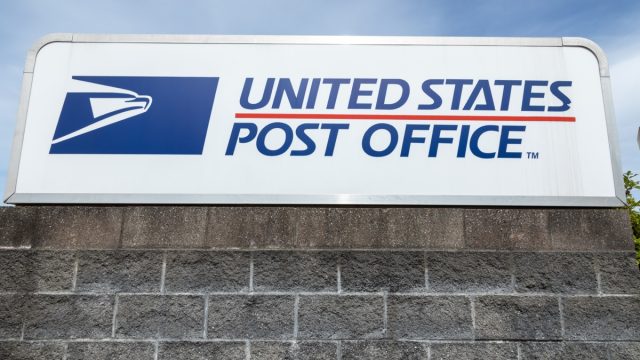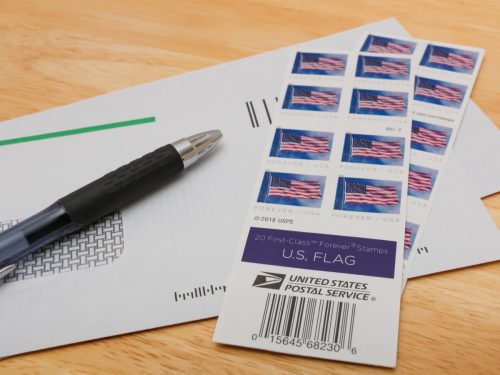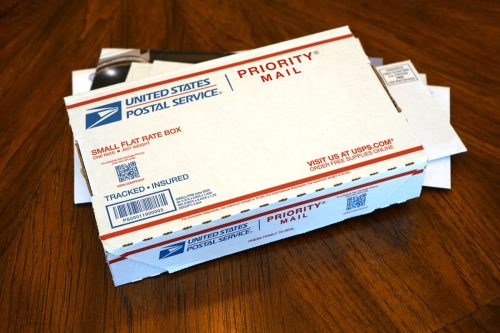"No End in Sight" to USPS Price Hikes, Former Treasurer Warns
"We haven’t been told when this will stop," the ex-USPS treasurer and VP of pricing said.

At this point, price hikes are nothing new for the U.S. Postal Service (USPS). Most recently, on July 9, the agency raised the price of First-Class Mail by 5.4 percent and brought the cost of the Forever stamp from 63 cents to 66 cents. This was on top of an increase in January, which had raised the stamp price from 60 cents to 63 cents, as well as the price of several shipping services. These biannual increases are part of an ongoing plan—and customers shouldn't expect them to let up any time soon. In fact, former USPS treasurer and vice president of pricing Steve Kearney says there's "no end in sight" to these price hikes. Read on to find out why your mail costs may keep going on.
RELATED: See a Sticker on Your Mailbox? Don't Touch It, USPS Says.
Regular price increases are part of a larger plan.

Postmaster General Louis DeJoy previously addressed the rising prices in an interview last year, in which he said that Americans should prepare for prices to keep going up at an "uncomfortable" rate. In a more recent interview with Federal News Network, DeJoy again spoke on pricing, arguing that the hikes are necessary.
"I would be negligent not to use our pricing authority," DeJoy told the outlet. "It is not my job to subsidize products that can't afford the price of a stamp."
Upping the costs is intended to help the USPS become more financially stable, as part of the 10-year Delivering for America (DFA) plan, which was established in 2021. But while this revenue is supposed to be helpful, Kearney, who is now executive director of the Alliance of Nonprofit Mailers, warns that the ongoing increases are painful for some of the agency's biggest customers.
RELATED: USPS Is Making These Changes to Your Mail.
Price hikes don't appear to have an ending.

The average American certainly feels the pain when going to buy a book of stamps that keeps getting more and more expensive. But these prices are becoming even more exorbitant for organizations that rely on the Postal Service for larger business operations.
The Alliance of Nonprofit Mailers assists not-for-profit organizations in preserving access to affordable mail services—and according to Kearney, they're also wondering when these hikes will come to an end.
"There's a lot of talk among mailers that they're being forced to reduce their mail volume, and some are making major, strategic moves out of mail—not only because of what's happened so far, but because there's just no end in sight," Kearney told Federal News Network. "We haven't been told when this will stop."
Steve Schiavone, director of print supply chain at Consumer Reports, added that in order to attract new subscribers, the nonprofit is reducing its direct mail program, as "it's just getting more and more expensive." Schiavone noted that postage accounts for over half of the magazine's costs.
Schiavone also argued that demand goes down as these prices trend upward—and he's hoping the USPS Board of Governors (the agency's governing body) eventually steps in to say, "This is crazy." He added, "Print is fragile, and you're basically killing all volume."
RELATED: USPS Is Getting Rid of These Mailing Options.
It's not all bad news.

While Schiavone had a few gripes about pricing, he also told Federal News Network that he's noticed an uptick in on-time deliveries.
"I've seen better delivery since last December than I've seen in my 20 years here," he said. "I'm saying that at a national level. At a local level, there have been people having issues with deliveries. But I'm saying if I aggregated from how we look at delivery, for our marketing campaigns and our periodicals, they've been doing very, very well."
This echoes statements from DeJoy, who said that 99 percent of the population is getting mail and packages within three days. First-Class mail is doing even better, with the Postmaster General noting that it's getting delivered a day ahead of schedule.
RELATED: For more up-to-date information, sign up for our daily newsletter.
DeJoy claims that complaints are "very, very small."

In his new interview, DeJoy also pointed out that since USPS doesn't have a "monopoly" anymore, mail delivery isn't as profitable as it once was. Still, this aspect of the agency's business is its "life-sustaining operation," he said.
While he's no stranger to criticism, DeJoy said that when the agency does get complaints about deliveries, they're from areas that are more "remote."
"The complaints that we get are very, very small, but concentrated," DeJoy told Federal News Network. "And it's important, we're trying to fix that. But it mostly has to do with labor availability in these remote areas."





















